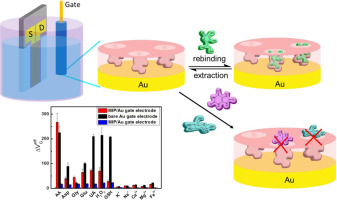Biosensors and Bioelectronics ( IF 12.6 ) Pub Date : 2017-09-07 , DOI: 10.1016/j.bios.2017.09.006 Lijun Zhang , Guiheng Wang , Di Wu , Can Xiong , Lei Zheng , Yunsheng Ding , Hongbo Lu , Guobing Zhang , Longzhen Qiu

|
In this study, an organic electrochemical transistor sensor (OECT) with a molecularly imprinted polymer (MIP)-modified gate electrode was prepared for the detection of ascorbic acid (AA). The combination of the amplification function of an OECT and the selective specificity of MIPs afforded a highly sensitive, selective OECT sensor. Cyclic voltammetry and electrochemical impedance spectroscopy measurements were carried out to monitor the stepwise fabrication of the modified electrodes and the adsorption capacity of the MIP/Au electrodes. Atomic force microscopy was employed for examining the surface morphology of the electrodes. Important detection parameters, pH and detection temperature were optimized. With the change in the relative concentration of AA from 1 μM to 100 μM, the MIP-OECT sensor exhibited a low detection limit of 10 nM (S/N > 3) and a sensitivity of 75.3 μA channel current change per decade under optimal conditions. In addition, the MIP-OECT sensor exhibited excellent specific recognition ability to AA, which prevented the interference from other structurally similar compounds (e.g., aspartic acid, glucose, uric acid, glycine, glutathione, H2O2), and common metal ions (K+, Na+, Ca2+, Mg2+, and Fe2+). In addition, a series of vitamin C beverages were analyzed to demonstrate the feasibility of the MIP-OECT sensor. Using the proposed principle, several other sensors with improved performance can be constructed via the modification of organic electrochemical transistors with appropriate MIP films.
中文翻译:

基于有机电化学晶体管的高选择性和灵敏传感器,用于检测抗坏血酸
在这项研究中,制备了带有分子印迹聚合物(MIP)修饰的栅电极的有机电化学晶体管传感器(OECT),用于检测抗坏血酸(AA)。OECT的扩增功能与MIP的选择性特异性相结合,提供了高度灵敏的选择性OECT传感器。进行了循环伏安法和电化学阻抗谱测量,以监测改性电极的逐步制造以及MIP / Au电极的吸附能力。原子力显微镜用于检查电极的表面形态。优化了重要的检测参数,pH和检测温度。随着AA相对浓度从1μM变为100μM,MIP-OECT传感器的检测限低至10 nM(S / N> 3)且在最佳条件下每十年每通道变化75.3μA的灵敏度。此外,MIP-OECT传感器对AA表现出出色的特异性识别能力,从而防止了其他结构相似的化合物(例如天冬氨酸,葡萄糖,尿酸,甘氨酸,谷胱甘肽,H2 O 2)和常见的金属离子(K +,Na +,Ca 2 +,Mg 2+和Fe 2+)。此外,还分析了一系列维生素C饮料,以证明MIP-OECT传感器的可行性。使用提出的原理,可以通过使用适当的MIP膜对有机电化学晶体管进行修饰来构造其他几种性能得到改善的传感器。



























 京公网安备 11010802027423号
京公网安备 11010802027423号